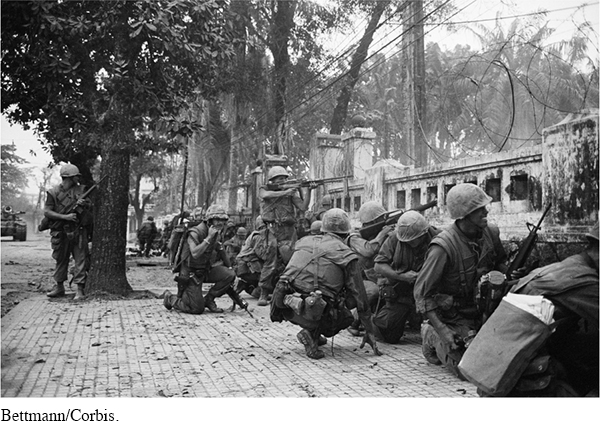The American Promise: Printed Page 846
The American Promise, Value Edition: Printed Page 766
The American Promise: A Concise History: Printed Page 875
The Tet Offensive and Johnson’s Move toward Peace
The American Promise: Printed Page 846
The American Promise, Value Edition: Printed Page 766
The American Promise: A Concise History: Printed Page 875
Page 846The year 1968 was marked by violent confrontations around the world. Protests against governments erupted from Mexico City to Paris to Tokyo, usually led by students in collaboration with workers. (See “Beyond America’s Borders: 1968: A Year of Protest.”) American society became increasingly polarized. The so-
The American Promise: Printed Page 846
The American Promise, Value Edition: Printed Page 766
The American Promise: A Concise History: Printed Page 875
Page 847Grave doubts penetrated the administration itself. Secretary of Defense Robert McNamara, a principal architect of U.S. involvement, now believed that the North Vietnamese “won’t quit no matter how much bombing we do.” He feared for the image of the United States, “the world’s greatest superpower, killing or seriously injuring 1,000 noncombatants a week, while trying to pound a tiny, backward nation into submission on an issue whose merits are hotly disputed.” McNamara left the administration in early 1968, but he kept his concerns private and did not publicly oppose the war.

A critical turning point came with the Tet Offensive. On January 30, 1968, the North Vietnamese and Vietcong launched a campaign of attacks on key cities, every major American base, and the U.S. Embassy in Saigon during Tet, the Vietnamese New Year holiday. Although the enemy was eventually pushed back and lost ten times as many soldiers as ARVN and U.S. forces, Tet was psychologically devastating to the United States because it exposed the credibility gap between official statements and the war’s reality. The attacks created a million more South Vietnamese refugees as well as widespread destruction. Public approval of Johnson’s handling of the war dropped to 26 percent.
The American Promise: Printed Page 846
The American Promise, Value Edition: Printed Page 766
The American Promise: A Concise History: Printed Page 875
Page 848In the aftermath of Tet, Johnson conferred with advisers in the Defense Department and an unofficial group of foreign policy experts who had been key architects of Cold War policy since the 1940s. Dean Acheson, who had been Truman’s secretary of state, summarized their conclusion: “We can no longer do the job we set out to do in the time we have left and we must begin to take steps to disengage.”
On March 31, 1968, Johnson announced a sharp reduction in the bombing of North Vietnam and an offer to begin peace talks. He added the stunning declaration that he would not run for reelection. The gradual escalation of the war was over, and military strategy shifted from “Americanization” to “Vietnamization” of the war. But this was not a shift in policy. The goal remained a non-
Negotiations began in Paris in May 1968. The United States would not agree to recognize the Hanoi government’s National Liberation Front, to allow a coalition government in the South, or to withdraw. The North Vietnamese would agree to nothing less. Although the talks continued, so did the fighting.
Meanwhile, violence escalated at home. Protests struck two hundred college campuses in the spring of 1968. In the bloodiest action, students occupied buildings at Columbia University in New York City, condemning the university’s war-